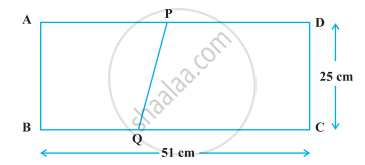Advertisements
Advertisements
प्रश्न
Prove that the points (2,3), (-4, -6) and (1, 3/2) do not form a triangle.
उत्तर
The distance d between two points `(x_1,y_1)` and `(x_2,y_2)` is given by the formula
`d = sqrt((x_1 - x_2)^2 + (y_1 - y_2)^2)`
In any triangle the sum of lengths of any two sides need to be greater than the third side.
Here the three points are A(2, 3), B(-4, -6) and C(1, 3/2)
Let us now find out the lengths of all the three sides of the given triangle.
`AB = sqrt((2 + 4)^2 + (3 + 6)^2)`
`= sqrt((6)^2 + (9)^2)`
`= sqrt(36 + 81)`
`AB = sqrt(117)`
`BC = sqrt((-4 -1)^2 + (-6 - 3/2)^2)`
`= sqrt((-5)^2 + ((-15)/2)^2)`
`= sqrt(25 + 225/4)`
`BC = sqrt(81.24)`
`AC = sqrt((2 - 1)^2 + (3 - 3/2)^2)`
` = sqrt((1)^2 + (3/2)^2)`
`= sqrt(1 + 9/4)`
`AC = sqrt(3.25)`
Here we see that, BC + AC not greater than AB
This is in violation of the basic property of any triangle to exist. Therefore these points cannot give rise to a triangle.
Hence we have proved that the given three points do not form a triangle.
APPEARS IN
संबंधित प्रश्न
If A(−4, 8), B(−3, −4), C(0, −5) and D(5, 6) are the vertices of a quadrilateral ABCD, find its area.
Find a relation between x and y if the points (x, y), (1, 2) and (7, 0) are collinear.
The two opposite vertices of a square are (− 1, 2) and (3, 2). Find the coordinates of the other two vertices.
Show that points A (a, b + c), B (b, c + a), C (c, a + b) are collinear.
Find the area of Δ ABC whose vertices are:
A (1,2) B (-2,3) and C (-3,-4)
Show that the points (a + 5, a – 4), (a – 2, a + 3) and (a, a) do not lie on a straight line for any value of a.
The value of the determinant `abs((1,"x","x"^3),(1,"y","y"^3),(1,"z","z"^3))` is ____________.
The area of the triangle ABC with the vertices A(-5, 7), B(-4, -5) and C(4, 5) is ______.
A(6, 1), B(8, 2) and C(9, 4) are three vertices of a parallelogram ABCD. If E is the midpoint of DC, find the area of ∆ADE.
The dimensions of a rectangle ABCD are 51 cm × 25 cm. A trapezium PQCD with its parallel sides QC and PD in the ratio 9 : 8, is cut off from the rectangle as shown in the following figure. If the area of the trapezium PQCD is `5/6` th part of the area of the rectangle, find the lengths QC and PD.

